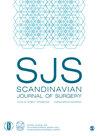RETRACTED: Assessment of Intraoperative Flow Measurement as a Quality Control During Carotid Endarterectomy: A Single-Center Analysis.
IF 2.5
3区 医学
Q1 SURGERY
引用次数: 0
Abstract
BACKGROUND To evaluate the technical results of the arterial repair, a variety of intraoperative imaging and assessment techniques can be used during carotid endarterectomy. The aim of the study was to evaluate the usefulness of intraoperative ultrasound flow measurement as a quality control after primary carotid endarterectomy in the setting of a teaching hospital. METHODS One hundred and seven consecutive carotid endarterectomies were performed over 24 months at our institution. Retrospectively acquired demographics, intraoperative flow measurements, duplex results, revisions, and surgical outcomes were reviewed. Postoperative 30-day transient ischemic attack, stroke, and death rates were analyzed. Results were compared with ultrasound flow measurement and duplex ultrasonography. RESULTS From March 2013 to March 2015, 107 primary consecutive carotid endarterectomies were performed in 107 patients (71% male, 29% female). The age ranged from 51 to 81 years with a mean age of 68 ± 4 years. Associated risk factors included diabetes 89 (83%), smoking 92 (86%), hypertension 94 (87.8%), chronic renal insufficiency 71 (66%), and coronary artery disease 57 (53%). Early postoperative duplex scans in all 107 patients showed no significant changes from intraoperative findings. The ipsilateral stroke and death rate in this study was 0 (0/107) and 30-day death and stroke rate was also 0 (0/107), with no significant difference between trainees and senior surgeons. Three patients (2.8 %) had flow <100 mL/min and two of them were revised after completion contrast angiography. CONCLUSION The findings of this study indicate that the intraoperative flow measurement is an alternative method for detecting technical errors and a tool for quality control imaging. Especially for the trainees, it makes sense to ensure effectiveness of the procedure upon its completion and to assess the technical adequacy of carotid endarterectomy.颈动脉内膜切除术中术中流量测量作为质量控制的评估:一项单中心分析。
本文章由计算机程序翻译,如有差异,请以英文原文为准。
求助全文
约1分钟内获得全文
求助全文
来源期刊
CiteScore
5.50
自引率
4.20%
发文量
37
审稿时长
6-12 weeks
期刊介绍:
The Scandinavian Journal of Surgery (SJS) is the official peer reviewed journal of the Finnish Surgical Society and the Scandinavian Surgical Society. It publishes original and review articles from all surgical fields and specialties to reflect the interests of our diverse and international readership that consists of surgeons from all specialties and continents.

 求助内容:
求助内容: 应助结果提醒方式:
应助结果提醒方式:


